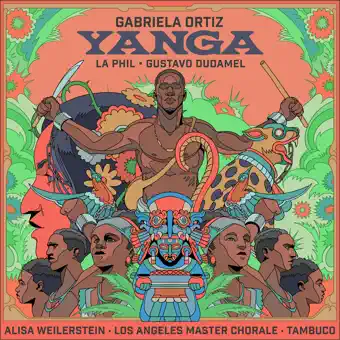september 2025
Gabriela Ortiz: Yanga
Los Angeles Philharmonic Orchestra o.l.v. Gustavo Dudamel
Nieuwe werken van Gabriela Ortiz – een andere geïnterviewde in de vorige uitgave – waaronder een celloconcert en een groot koor-/orkeststuk, worden krachtig bepleit.

Gustavo Dudamels vorige album met muziek van Gabriela Ortiz bevatte Altar de cuerda, een prachtig concert voor Maria Dueñas (8/24). En nu, amper een jaar later, is hij terug met Dzonot, een even betoverend concert voor Alisa Weilerstein. Dzonot is het Mayawoord voor cenotes, met water gevulde grotten op het schiereiland Yucatán. Na een bezoek aan deze cenotes kan ik instaan voor hun mysterieuze sfeer – de donkere poelen verlicht door fijne zonnestralen die hun weg vinden door scheuren en openingen in de rotsen erboven.
Ortiz geeft een schilderachtig beeld van deze donker verlichte kamers in het eerste deel van het concert, 'Vertical Light', terwijl Weilerstein in een buitenaards hoog register door het water zwemt. Dit gaat over in een scherzo-achtig deel, 'Eye of the Jaguar', waar de cello op jacht lijkt te zijn, zij het met wilde elegantie. In 'Jade', het exotisch lyrische langzame deel, bevatten de sonoriteiten van de solist drones die misschien iets oerouds suggereren, terwijl de finale verwijst naar de Maya-legende van de Toh-vogel in muziek die vliegt, fladdert en ook worstelt. Weilerstein en de Los Angelesos spelen Dzonot met zoveel overtuiging en technisch meesterschap dat ik even moest kijken toen ik in het boekje las dat deze opname afkomstig is van de première-uitvoeringen.
Yanga werd geschreven in opdracht van Dudamel en de LA Phil, die vroegen om een koor-/orkestwerk te programmeren naast Beethovens Negende. De titel verwijst naar de 16e-eeuwse Afrikaanse prins die als slaaf naar Mexico werd gebracht, ontsnapte en als vluchteling leefde. Met de hulp van andere slaven die hij hielp ontsnappen, organiseerde hij invallen op Spaanse karavanen, wat hem de mogelijkheid gaf een deal met de kroon te sluiten die hem en zijn volk in staat stelde vrij te leven. De tekst, van Santiago Martín Bermúdez, bevat ook gezangen van Congolese oorsprong, en Ortiz gebruikt een kwartet percussionisten die een batterij Afrikaanse instrumenten bespelen die slaven meebrachten naar Latijns-Amerika. Het zal geen verrassing zijn dat Yanga een briljant kleurrijke, ritmisch vitale en uiteindelijk opbeurende cantate is die volgens Ortiz 'spreekt over de grootsheid van de mensheid op zoek naar gelijkheid'.
De Seis Piezas a Violeta werden in 2002 gecomponeerd voor piano en strijkers; de versie die hier te horen is, werd op verzoek van Dudamel bewerkt voor strijkorkest. Hoewel bedoeld als een eerbetoon aan de Chileense zangeres en folkloriste Violet Parra, hoor ik in de muzikale verwijzingen eerder Messiaen en Ligeti dan iets folkloristisch. Hoewel het cerebraler is dan zijn discgenoten, is het desalniettemin prachtig – met name het delicate vierde deel (‘Song of the Little Angel’) en de afsluitende ‘Amen’ met zijn glanzende, wolkachtige lagen.
Ik ben Dudamel, de LA Phil en Platoon enorm dankbaar voor hun voortdurende toewijding aan Ortiz’ muziek.

Gustavo Dudamel’s previous album of Gabriela Ortiz’s music featured Altar de cuerda, a knockout of a concerto for Maria Dueñas (8/24). And now, barely a year later, he’s back with Dzonot, an equally alluring concerto for Alisa Weilerstein. Dzonot is the Mayan word for cenotes, water-filled caves that are found on the Yucatán Peninsula. Having visited these cenotes, I can vouch for their mysterious atmosphere – the dark pools illuminated in fine shafts of sunlight that find their way through cracks and openings in the rock overhead.
Ortiz gives a painterly sense of these darkly luminous chambers in the concerto’s first movement, ‘Vertical Light’, as Weilerstein swims through the waters in an other-worldly high register. This segues into a scherzo-like section, ‘Eye of the Jaguar’, where the cello appears to be on the hunt, albeit with feral elegance. In ‘Jade’, the exotically lyrical slow movement, the soloist’s sonorities include drones that suggest something ancient, perhaps, while the finale refers to the Mayan legend of the Toh bird in music that flies, flutters and also struggles. Weilerstein and the Los Angelenos play Dzonot with such conviction and technical mastery that I did a double take when I read in the booklet that this recording is taken from the premiere performances.
Yanga was commissioned by Dudamel and the LA Phil, who asked for a choral/orchestral work to be programmed alongside Beethoven’s Ninth. The title refers to the 16th-century African prince who was brought to Mexico as a slave, escaped and lived as a fugitive. With the help of other slaves whom he helped to escape, he organised raids on Spanish caravans, which gave him leverage to strike a deal with the crown that allowed him and his people to live freely. The text, by Santiago Martín Bermúdez, also includes chants of Congo origins, and Ortiz employs a quartet of percussionists playing a battery of African instruments that enslaved people brought with them to Latin America. It should come as no surprise that Yanga is a brilliantly colourful, rhythmically vital and ultimately uplifting cantata that Ortiz says ‘speaks of the greatness of humanity when in search of equality’.
The Seis Piezas a Violeta were composed in 2002 for piano and strings; the version heard here was adapted for string orchestra at Dudamel’s request. Although meant as a homage to the Chilean singer and folklorist Violet Parra, I hear Messiaen and Ligeti in its musical references rather than anything folkloric. More cerebral than its disc-mates, it’s beautiful nonetheless – particularly the delicate fourth movement (‘Song of the Little Angel’) and the final ‘Amen’ with its lustrous cloud-like layers.
I, for one, am immensely grateful to Dudamel, the LA Phil and Platoon for their ongoing commitment to Ortiz’s music.
